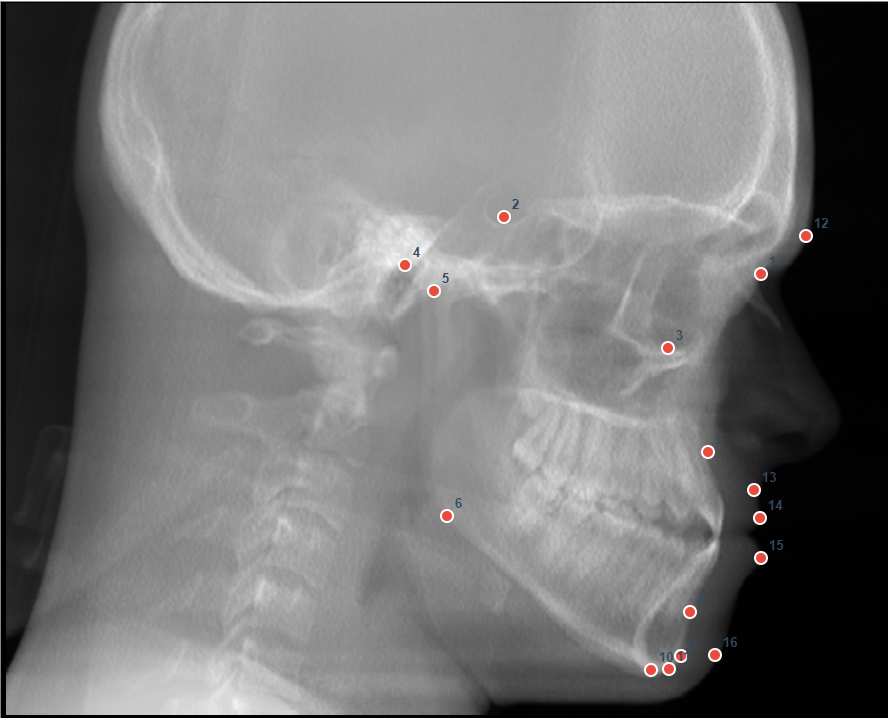Upload a lateral cephalogram, then click on the image to mark each landmark in order. Results will appear after all landmarks are marked.
Table of Contents
Landmarks to Mark (in order):
- Nasion (N): It marks the midpoint at the intersection of the frontonasal suture with the internasal suture joining the nasal bones.
- Sella (S): Point representing the midpoint of the pituitary fossa
- Orbitale (Or): The lowest point on the inferior margin of the orbit
- Porion (Po): The most superior and outer point of the external auditory meatus
- Articulare (Ar): A Point at the junction of the posterior border of the ramus and the inferior border of the posterior cranial base
- Gonion (Go): A point on the curvature of the angle of the mandible located by bisecting the angle formed by lines tangent to the posterior ramus and the inferior border of the mandible
- Point A (A): A key landmark on the maxilla, specifically the deepest point on the alveolar process anteriorly
- Point B (B): The most posterior point of the concavity on the anterior surface of the mandibular symphysis
- Pogonion (Pg): The most anterior point on the mandibular symphysis
- Menton (Me): The most inferior point on the mandibular symphysis
- Gnathion (Gn): The most anterior, inferior point on the mandibular symphysis
- Glabella (G): Most anterior point on the soft tissue contour of the forehead
- Subnasale (Sn): The most posterior superior point on the nasolabial curvature
- Labrale Superius (Ls): The most anterior point on the margin of the upper lip
- Labrale Inferius (Li): The uppermost point on the vermilion of the lower lip
- Soft Tissue Pogonion (Pg’): The most anterior point on the soft tissue chin in the mid-sagittal plane

What is COGS Analysis?
COGS (Cephalometrics for Orthognathic Surgery) analysis is a comprehensive cephalometric assessment developed specifically for diagnosing and planning treatment in patients requiring orthognathic (jaw) surgery. Unlike traditional cephalometric analyses, COGS examines both hard and soft tissues, including the cranial base, skeletal structures, dental relationships, and facial forms. This analysis uses a series of linear and angular measurements to evaluate jaw positions, facial heights and widths, tooth angulations, and overall facial contour145.
Why is COGS Analysis Important?
COGS analysis is one of the most widely used tools for orthognathic surgical diagnosis and treatment planning. It provides a detailed evaluation of:
- Maxillary and mandibular positions
- Vertical and horizontal skeletal discrepancies
- Dental relationships
- Facial proportions and soft tissue harmony
This level of detail helps orthodontists and surgeons collaborate effectively, ensuring the best possible outcomes for patients undergoing jaw surgery456.
What Does COGS Analysis Measure?
COGS analysis consists of 37 parameters grouped under seven main headings:
Take the first step to a better Oral health!
Get tips on Oral health and discover ways to improve your Dental health. Sign up today
- Cranial base
- Horizontal skeletal
- Vertical skeletal
- Dental lines and angles
- Maxilla-mandible relationship
- Facial form
- Lip position and form
These measurements are used to diagnose issues such as maxillary or mandibular protrusion/retrusion, facial asymmetry, and dental compensations, all of which are crucial for precise surgical planning.
Introducing the COGS Analysis Tool
To simplify the complex process of COGS analysis, I have developed an interactive COGS Analysis Tool. This web-based tool allows clinicians, students, and researchers to:
- Upload a lateral cephalogram (X-ray of the side of the head)
- Mark key anatomical landmarks directly on the image
- Automatically calculate essential COGS measurements
- Receive instant interpretation and suggestions based on standard norms
How Does the Tool Work?
- Upload your patient’s lateral cephalogram.
- Mark the required bony and soft tissue landmarks as prompted by the tool.
- The tool will calculate key linear and angular measurements such as SNA, SNB, ANB, facial heights, and more.
- Results are displayed in a clear table, showing your measured value, the normal value, and an interpretation with clinical suggestions.
This tool is designed to save time, reduce manual errors, and make COGS analysis accessible to both experienced clinicians and those new to cephalometrics.
Why Use This Tool?
- Streamlines complex analysis: No need for manual tracing or calculations.
- Educational value: Great for students learning cephalometric analysis.
- Clinical accuracy: Based on widely accepted COGS parameters and population norms.
- Instant feedback: Get actionable insights for diagnosis and treatment planning.
Conclusion
COGS analysis is a cornerstone of orthognathic surgical planning, offering a detailed roadmap for correcting skeletal and dental discrepancies. With the interactive COGS Analysis Tool, you can harness the power of this comprehensive analysis quickly and accurately-helping you deliver the best possible outcomes for your patients.
- Steiner’s Cephalometric Analysis – Free cephalometric analysis - June 7, 2025
- COGS CEPHALOMETRIC ANALYSIS – FREE TO USE - June 7, 2025
- Can You Eat on Root Canal Treated Teeth? Everything You Need to Know - May 18, 2025


